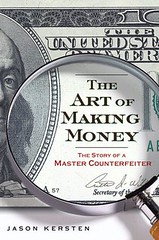
PREV ARTICLE
NEXT ARTICLE
FULL ISSUE
PREV FULL ISSUE
INTERVIEW WITH ART OF COUNTERFEITING AUTHOR Two weeks ago I excerpted a review of the new book by Jason Kersten, The Art of Making Money: The Story of a Master Counterfeiter. An E-Sylum reader forwarded this story, a TIME magazine interview with the author. -Editor  But the U.S. Treasury Department was no match for Art Williams, one of the most inventive and prolific counterfeiters of recent decades. After learning the craft at 16 from his mother's boyfriend, Williams, the product of a tough neighborhood on Chicago's South Side, went on to print an estimated $10 million in fake money by outmaneuvering the government's ever-tightening security measures. Color-changing ink was replicated by automotive paint; watermarks were painstakingly sketched by hand; a close copy of the secret paper came from leftover newsprint rolls made at local mills. Williams had a successful 10-year run before he was finally caught by the U.S. Secret Service and sentenced in 2002 to three years in prison. But the U.S. Treasury Department was no match for Art Williams, one of the most inventive and prolific counterfeiters of recent decades. After learning the craft at 16 from his mother's boyfriend, Williams, the product of a tough neighborhood on Chicago's South Side, went on to print an estimated $10 million in fake money by outmaneuvering the government's ever-tightening security measures. Color-changing ink was replicated by automotive paint; watermarks were painstakingly sketched by hand; a close copy of the secret paper came from leftover newsprint rolls made at local mills. Williams had a successful 10-year run before he was finally caught by the U.S. Secret Service and sentenced in 2002 to three years in prison.You say that, unlike other criminals, counterfeiters are craftsmen. Is there a part of you that admires the work that they do? Well, sure. I've seen one of Art's bills. It's just astonishing how similar it is to the genuine article. I tend to be fascinated by any master criminal, anyone who's such a diabolical genius that they take a crime beyond the financial gain. One striking detail of the story is how Art and his wife would travel around the country and unload their fake bills by buying random supplies and souvenirs, getting real money in change. Then they donated those supplies to charity. They'd have all this extra stuff, and they'd drop it off at Salvation Armies and churches. That became as important to them as the money itself, that feeling of charity. He wasn't a greedy counterfeiter. Why do you think he agreed to talk to you? Was part of him proud, and wanted to boast? Absolutely. You can see in the earlier part of the book that he's a good kid, and he's a smart kid. He skips two grades, he's a straight-A student. That all gets subverted once he goes into the projects in Chicago. I think that 12-year-old kid is still in there wanting to come out, and I think it did with his counterfeit bills. What was it like to spend time together? Our core interviews for the book took place over 10 days in a basement apartment on the South Side of Chicago. I was just pulling these stories from his childhood out of him. It was a very emotional process - he would break down crying, telling me about his mother going crazy and his dad abandoning him. That's when the book sort of took a different direction. Yes, it's a book about counterfeiting, but then I started seeing it as the story of a man and his life, and how those things were interwoven. To read the complete article, see: Q&A: The Art of Counterfeiting Money (news.yahoo.com/s/time/20090615/us_time/08599190459500) To read the earlier E-Sylum article, see: NEW BOOK: THE ART OF MAKING MONEY: THE STORY OF A MASTER COUNTERFEITER (www.coinbooks.org/esylum_v12n23a04.html) The reader also included a link to this short, but informative article on how to detect a counterfeit U.S. note. Nothing most numismatists don't already know, but a good fresher. How to Spot Counterfeit Money (www.divinecaroline.com/22287/73997-spot-counterfeit-money) Wayne Homren, Editor The Numismatic Bibliomania Society is a non-profit organization promoting numismatic literature. See our web site at coinbooks.org. To submit items for publication in The E-Sylum, write to the Editor at this address: whomren@gmail.com To subscribe go to: https://my.binhost.com/lists/listinfo/esylum All Rights Reserved. NBS Home Page Contact the NBS webmaster 
|